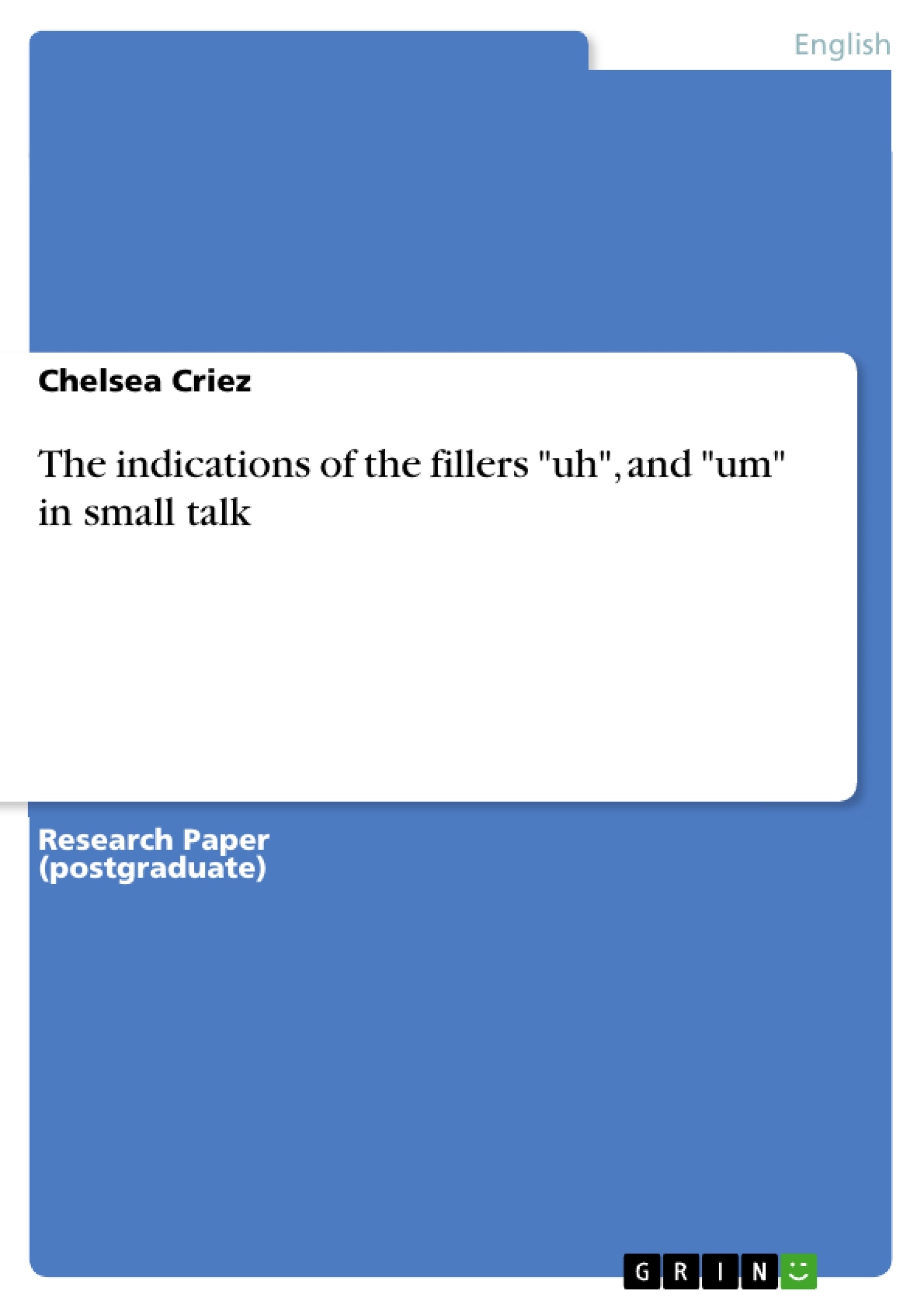This paper will address the issue of "uh" and "um". The idea for this paper came around while listening to a Teacher’s Assistant give a lecture; she had used "uh" twenty-six times and used "um" nineteen times (needless to say I do not recall what the lecture was about, nor which class it was for). Then the following questions popped into mind: why do we use "uh" and "um"? And why are they so marked? After some research and surveying, I found that "uh" and "um" are useful to the speaker as well as the audience. "Uh" and "um" are used to let an audience know that there will either be a brief (uh) or a long (um) pause, a hesitation, or a pause for recall which I will show in my data presentation and interpretation.
In many studies of uh and um, the conclusions were similar to my findings. Clark and Fox Tree (2002) stated “that speakers use uh and um to announce that they are initiating what they expect to be a minor (uh), or major (um), delay in speaking. Speakers can use these announcements in turn to implicate, for example, that they are searching for a word, are deciding what to say next, want to keep the floor, or want to cede the floor”. Which I found to be consistent with my findings; a subject tended to continue with their speech almost immediately after using an uh and delayed a few seconds after they had used an um. Clark and Fox Tree found that uh and um had use and are in fact words, “By words, we mean linguistic units that have conventional phonological shapes and meanings and are governed by the rules of syntax and prosody”. The use of uh and um can be used to alert the audience “(1) that they wouldn’t normally expect a delay at this moment; (2) that they anticipated the delay; and (3) that they were aware, at some level, of the reason for their delay”. Clark and Fox Tree were able to prove uh and um have meaning and therefore are indeed words.
Inhaltsverzeichnis (Table of Contents)
- Introduction
- Background
- Uhs and Ums as Indicators of Delay
- Uhs and Ums as Indicators of Uncertainty
- Uhs and Ums as Indicators of Hesitation
- Uhs and Ums as Indicators of Recall
- Uhs and Ums Rate of Use
- Methodology
- Data Presentation and Analysis
- Interpretation
- Conclusion
- References
Zielsetzung und Themenschwerpunkte (Objectives and Key Themes)
This paper examines the use of "uh" and "um" in spoken language, exploring their function and meaning. The research is based on the author's personal observation of a teacher's assistant and subsequent investigations into the topic.
- The role of "uh" and "um" as indicators of delay in speech.
- The relationship between "uh" and "um" and speaker uncertainty.
- The argument for and against considering "uh" and "um" as words with specific meanings.
- The potential impact of "uh" and "um" on listener comprehension and memory.
Zusammenfassung der Kapitel (Chapter Summaries)
- Introduction: The paper introduces the topic of "uh" and "um" and outlines the author's motivation for exploring their use, stemming from an observation of a lecture.
- Background: This section delves into existing research on the functions of "uh" and "um." It examines the theories of Clark and Fox Tree (2002), who argue that these filler words signal delays in speech, and O'Connell and Kowal (2005), who offer a different perspective on their meaning.
- Uhs and Ums as Indicators of Delay: This subsection explores the findings of Clark and Fox Tree, who suggest "uh" and "um" announce minor and major delays in speaking, respectively, serving as cues for the listener. The author highlights the similarities and differences between their findings and those of Clark and Fox Tree.
- Uhs and Ums as Indicators of Uncertainty: This section examines O'Connell and Kowal's (2005) research, which suggests that "uh" and "um" may not have fixed meanings but can signal a lack of commitment or certainty on the part of the speaker. The author highlights the debate between these two perspectives.
- Uhs and Ums as Indicators of Hesitation: Here, the author explores the views of Corley and Stewart (2008), who argue that "uh" and "um" are not intentional but rather reflect hesitation in speech. The author relates their arguments to the author's own findings, which suggest a similar function.
- Uhs and Ums as Indicators of Recall: This subsection focuses on Fraundorf and Watson's (2011) research, which explores the potential role of "uh" and "um" in influencing memory during discourse. The author summarizes their findings, which suggest that these filler words can direct the speaker's attention to the speech stream and aid in memory retrieval.
Schlüsselwörter (Keywords)
The key terms and concepts explored in this paper include "uh," "um," filled pauses, speech disfluencies, delay, uncertainty, hesitation, recall, memory, speaker-listener interaction, discourse analysis, and linguistic pragmatics.
- Citation du texte
- Chelsea Criez (Auteur), 2015, The indications of the fillers "uh", and "um" in small talk, Munich, GRIN Verlag, https://www.grin.com/document/335275



